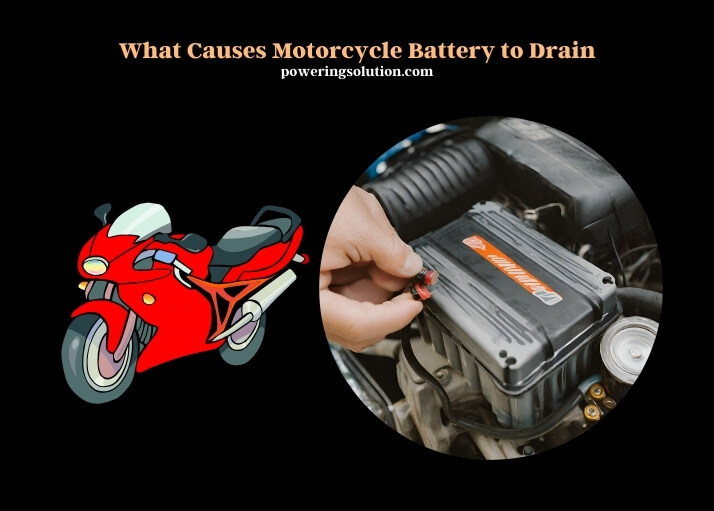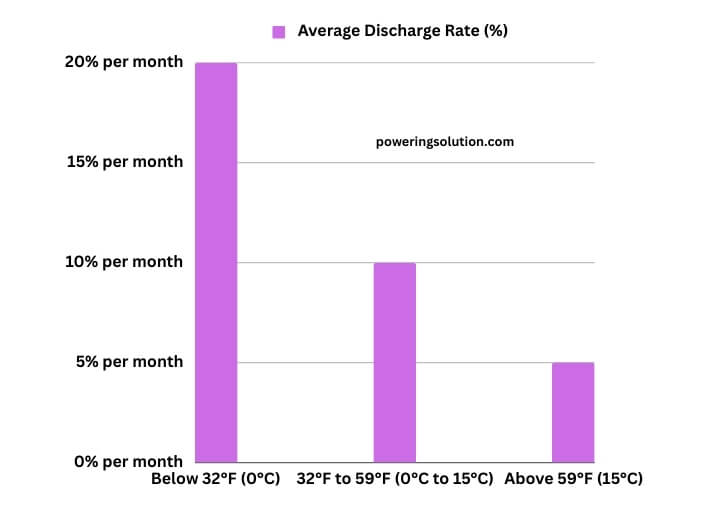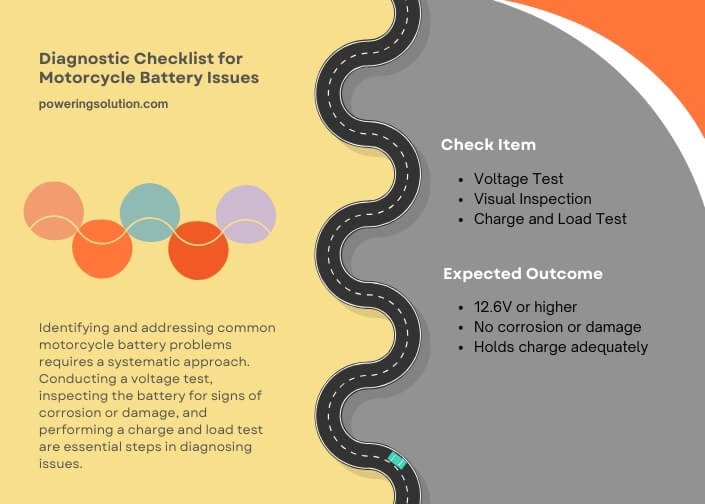Motorcycle battery drain can be attributed to a variety of factors including parasitic drains, aging, and a faulty charging system. These issues can lead to decreased battery life and performance, impacting the overall reliability of the motorcycle.
Parasitic drains occur when electrical devices continue to draw power from the battery even after the motorcycle has been turned off. This can be due to malfunctioning components or devices that are designed to remain on, such as alarm systems.
Over time, batteries naturally lose their ability to hold a charge. This aging process is accelerated by factors like extreme temperatures, infrequent use, and leaving the battery in a discharged state for extended periods. A faulty charging system, on the other hand, fails to replenish the battery’s charge while the motorcycle is running, leading to a gradual depletion of power.
Regular maintenance, including electrical system checks and battery care, is essential for identifying and mitigating these issues. Ensuring that the motorcycle’s charging system is functioning correctly and that the battery is kept clean and properly charged can significantly extend the life of the battery, enhancing the motorcycle’s reliability and performance.

Key Reasons Behind Motorcycle Battery Drain
Motorcycle batteries can lose charge for several reasons, with parasitic drains, aging, and faulty charging systems being the most common culprits. A parasitic drain occurs when electrical devices continue to draw power from the battery even after the motorcycle has been turned off.
This can be due to malfunctioning components or devices that are designed to remain on, like alarm systems. As batteries age, their ability to hold a charge diminishes, leading to more frequent drains. Faulty charging systems, on the other hand, fail to replenish the battery’s charge adequately while the motorcycle is in operation, resulting in a gradual loss of power.
Regular maintenance and electrical system checks are crucial to identify and rectify these issues, ensuring the battery’s longevity and reliable performance.
Accessories and Their Drain on Battery Life
Aftermarket accessories and electrical modifications can significantly impact a motorcycle battery’s drain rate. High-consumption devices such as LED lights, heated grips, and alarm systems increase the electrical load on the battery.
If the motorcycle’s charging system cannot compensate for this additional load, the battery may drain more quickly than expected. It’s essential to assess the balance between the battery’s capacity and the power demands of installed accessories to prevent unexpected battery depletion. Proper installation and usage of accessories can mitigate their impact on battery life.
How Temperature Influences Battery Performance
Temperature plays a critical role in the performance and health of motorcycle batteries. Extreme cold or heat affects the chemical reactions within the battery, leading to faster discharge rates and potentially reducing the battery’s overall lifespan. In cold conditions, batteries can lose their charge more rapidly, while high temperatures can lead to increased self-discharge rates and potential damage from overheating.
Battery Discharge Rates at Various Temperatures
| Temperature Range | Average Discharge Rate (%) |
| Below 32°F (0°C) | 20% per month |
| 32°F to 59°F (0°C to 15°C) | 10% per month |
| Above 59°F (15°C) | 5% per month |
Adopting preventive measures, such as storing the motorcycle in a temperature-controlled environment and using battery maintainers, can help mitigate these effects.

Extending Your Motorcycle Battery’s Life
To prolong the life of a motorcycle battery, riders should adhere to a regimen of regular charging, especially during periods of infrequent use. Choosing the right charger and employing a battery maintainer during the off-season can prevent the battery from entering a deep discharge state, which can irreversibly damage its capacity.
Keeping the battery clean and ensuring tight connections can also help maintain its health and longevity.
Troubleshooting Battery Issues
Identifying and addressing common motorcycle battery problems requires a systematic approach. Conducting a voltage test, inspecting the battery for signs of corrosion or damage, and performing a charge and load test are essential steps in diagnosing issues.
Diagnostic Checklist for Motorcycle Battery Issues
| Check Item | Expected Outcome |
| Voltage Test | 12.6V or higher |
| Visual Inspection | No corrosion or damage |
| Charge and Load Test | Holds charge adequately |
Seeking professional help is advisable when these steps do not resolve the issue, ensuring the motorcycle remains reliable and ready to ride.

Frequently Asked Questions (FAQs)
Can Faulty Ignition Switches Drain Motorcycle Batteries?
Faulty ignition switches are a less commonly discussed cause of motorcycle battery drain. These switches, when malfunctioning, can create an electrical pathway that allows power to flow even if the motorcycle is off, leading to a slow but steady drain of the battery.
This issue can be particularly insidious because it might not be immediately obvious to the rider. Regularly checking the ignition switch for signs of wear or damage and monitoring the motorcycle for any unusual electrical behavior can help identify this issue before it leads to a completely drained battery.
How Can I Prevent My Car Alarm from Draining My Battery like Motorcycle Battery Drainage?
To prevent car alarm battery drainage, consider installing a low-voltage cut-off device that automatically disables the alarm when the battery voltage drops. Regularly check for any faulty wiring or connections that may be causing excessive drain. Opting for a motorcycle battery drainage prevention system may also help.
Does Infrequent Use Lead to Battery Drain?
Infrequent use of a motorcycle can indeed lead to battery drain. Batteries naturally discharge over time, and without regular use, the motorcycle’s charging system doesn’t get the opportunity to recharge the battery.
This effect is compounded in motorcycles equipped with clocks, radio memory functions, and security systems that continue to draw small amounts of power even when the motorcycle is turned off. To combat this, riders can connect their motorcycle battery to a trickle charger, which maintains the battery at a full charge without overcharging it, thus extending its life.
Can a Bad Stator Cause Battery Drain?
A bad stator is another potential culprit for motorcycle battery drain. The stator, part of the motorcycle’s charging system, generates the electrical power needed to recharge the battery while the motorcycle is running.
If the stator is failing, it may not produce enough power to keep the battery charged, leading to a gradual drain. Symptoms of a bad stator can include dim lights, difficulty starting, and the battery not holding a charge. Testing the stator’s output with a multimeter can diagnose this issue.
Impact of Short Rides on Battery Life
Short rides can adversely affect motorcycle battery life. The charging system needs time to replenish the battery after the energy expended to start the engine. If the motorcycle is used only for short trips, the battery may not receive enough charge to compensate for the initial power used to start the motorcycle.
Over time, this can lead to a situation where the battery is consistently undercharged, reducing its overall lifespan. To mitigate this, riders should occasionally take their motorcycles on longer rides to allow the battery to fully charge.
Role of Corroded Battery Terminals in Power Drain
Corroded battery terminals can significantly contribute to motorcycle battery drain. Corrosion at the terminals can impede the flow of electricity, making it harder for the charging system to replenish the battery and for the battery to deliver power to the motorcycle’s electrical system.
This resistance can cause the battery to drain more quickly than it would otherwise. Regular cleaning of the battery terminals with a wire brush and applying a corrosion inhibitor can help maintain a good electrical connection and prevent battery drain.
How Does Riding Style Influence Battery Drain?
Riding style can indirectly influence motorcycle battery drain. Aggressive acceleration and frequent use of high-power accessories can increase the electrical load on the battery. If the motorcycle’s charging system is unable to keep up with the demand, the battery may end up being undercharged.
Consistently riding in a manner that maximizes electrical demand can shorten the battery’s lifespan by keeping it in a state of perpetual undercharge. Being mindful of accessory use and adopting a more conservative riding style can help ensure the battery remains adequately charged.
Summary
Motorcycle battery drain can be attributed to various factors, including parasitic drains, aging, faulty charging systems, the impact of accessories, and temperature effects. By understanding these causes and implementing strategies for maintenance and troubleshooting, riders can significantly improve their battery’s lifespan and performance, ensuring their motorcycle is always ready for the road.
